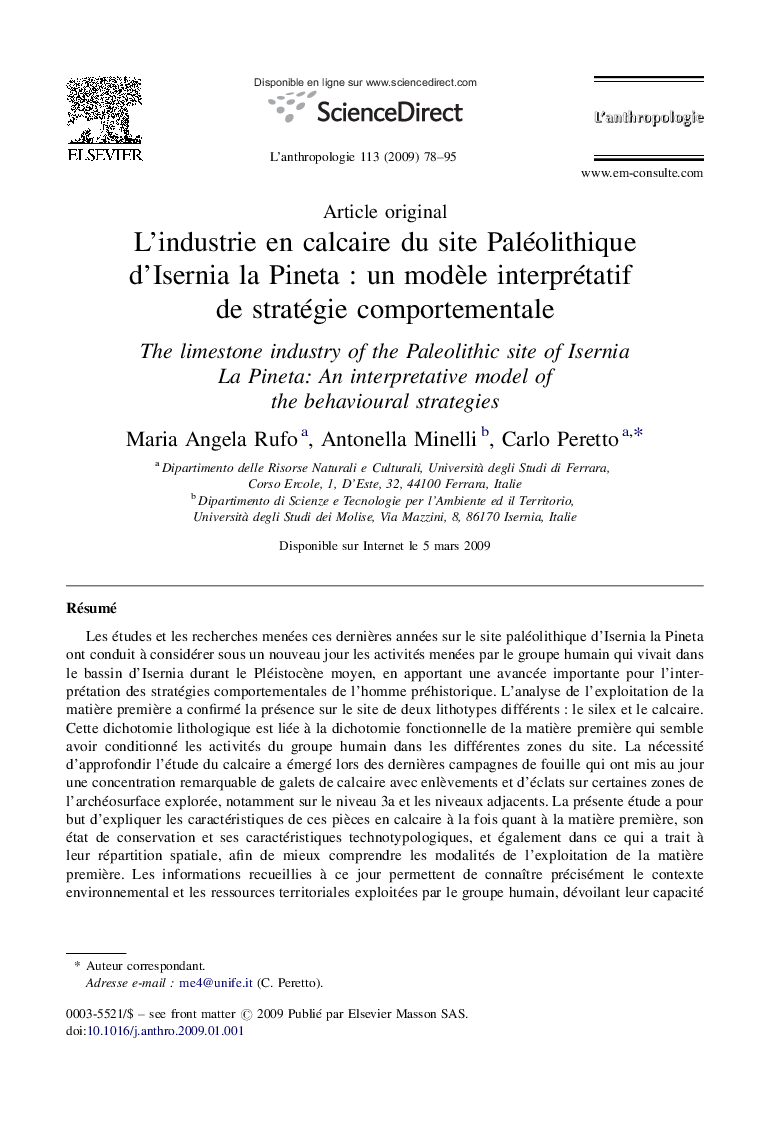| کد مقاله | کد نشریه | سال انتشار | مقاله انگلیسی | نسخه تمام متن |
|---|---|---|---|---|
| 1033912 | 943553 | 2009 | 18 صفحه PDF | دانلود رایگان |

RésuméLes études et les recherches menées ces dernières années sur le site paléolithique d’Isernia la Pineta ont conduit à considérer sous un nouveau jour les activités menées par le groupe humain qui vivait dans le bassin d’Isernia durant le Pléistocène moyen, en apportant une avancée importante pour l’interprétation des stratégies comportementales de l’homme préhistorique. L’analyse de l’exploitation de la matière première a confirmé la présence sur le site de deux lithotypes différents : le silex et le calcaire. Cette dichotomie lithologique est liée à la dichotomie fonctionnelle de la matière première qui semble avoir conditionné les activités du groupe humain dans les différentes zones du site. La nécessité d’approfondir l’étude du calcaire a émergé lors des dernières campagnes de fouille qui ont mis au jour une concentration remarquable de galets de calcaire avec enlèvements et d’éclats sur certaines zones de l’archéosurface explorée, notamment sur le niveau 3a et les niveaux adjacents. La présente étude a pour but d’expliquer les caractéristiques de ces pièces en calcaire à la fois quant à la matière première, son état de conservation et ses caractéristiques technotypologiques, et également dans ce qui a trait à leur répartition spatiale, afin de mieux comprendre les modalités de l’exploitation de la matière première. Les informations recueillies à ce jour permettent de connaître précisément le contexte environnemental et les ressources territoriales exploitées par le groupe humain, dévoilant leur capacité opportuniste à trouver la solution comportementale la plus avantageuse pour leurs besoins de subsistance.
The studies and the researches carried out in the last years on the Palaeolithic site of Isernia La Pineta have brought to consider in new way the activities realized by the human group that lived the basin of Isernia during the Middle Pleistocene offering an important key of interpretation of the behavioural strategies of the prehistoric man. The analysis of the exploitation of the raw material has confirmed the presence on the site of two different lithotypes: flint and limestone; the lithological dichotomy is related to the functional dichotomy of the raw material that seems to have conditioned the activities of the human group in different areas of the site. The necessity to deepen the study on the limestone has derived from the evidence brought to light in the last excavation campaigns of a remarkable concentration of the flaked limestone pebbles and the flake scars in some areas of the explored archeosurfaces, particularly on the 3a and on the overlooking layers. The present study has the purpose to explain the characteristics of the limestone finds both in reference to the raw material and to its state of preservation both to the technotypological evidences and its spatial distribution with the purpose to better understand the modalities of the exploitation of the raw material. The information collected until today have permitted to obtain a precise knowledge of the environmental context and the territorial resources exploited by the human group showing an opportunistic capability to find the most advantageous behavioural solution for the necessities of subsistence.
Journal: L'Anthropologie - Volume 113, Issue 1, January–March 2009, Pages 78–95